2016 SUBARU IMPREZA fuel pressure
[x] Cancel search: fuel pressurePage 506 of 594
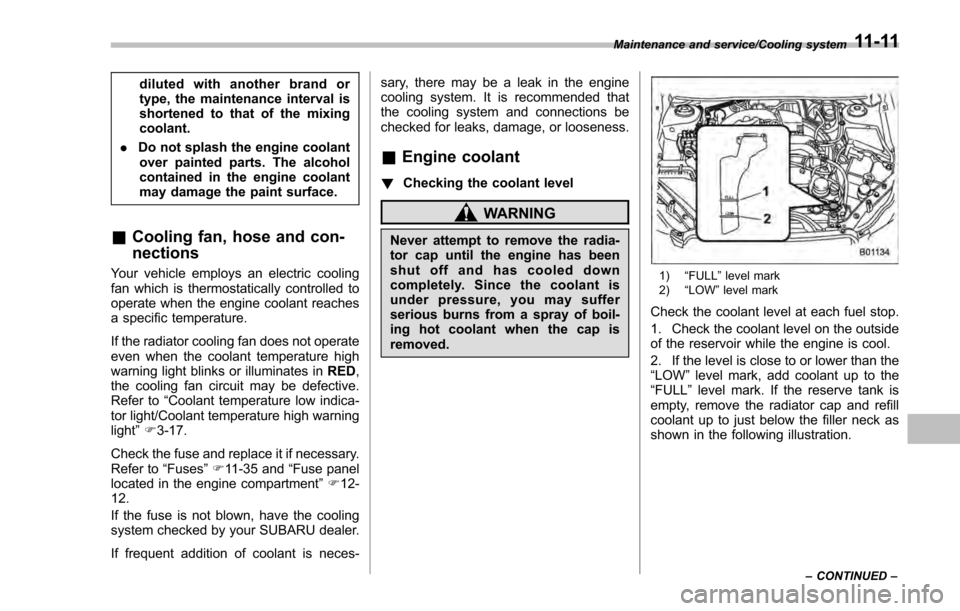
diluted with another brand or
type, the maintenance interval is
shortened to that of the mixing
coolant.
. Do not splash the engine coolant
over painted parts. The alcohol
contained in the engine coolant
may damage the paint surface.
& Cooling fan, hose and con-
nections
Your vehicle employs an electric cooling
fan which is thermostatically controlled to
operate when the engine coolant reaches
a specific temperature.
If the radiator cooling fan does not operate
even when the coolant temperature high
warning light blinks or illuminates in RED,
the cooling fan circuit may be defective.
Refer to “Coolant temperature low indica-
tor light/Coolant temperature high warning
light ”F 3-17.
Check the fuse and replace it if necessary.
Refer to “Fuses”F 11-35 and “Fuse panel
located in the engine compartment ”F 12-
12.
If the fuse is not blown, have the cooling
system checked by your SUBARU dealer.
If frequent addition of coolant is neces- sary, there may be a leak in the engine
cooling system. It is recommended that
the cooling system and connections be
checked for leaks, damage, or looseness.
&
Engine coolant
! Checking the coolant level
WARNING
Never attempt to remove the radia-
tor cap until the engine has been
shut off and has cooled down
completely. Since the coolant is
under pressure, you may suffer
serious burns from a spray of boil-
ing hot coolant when the cap is
removed.
1) “FULL ”level mark
2) “LOW ”level mark
Check the coolant level at each fuel stop.
1. Check the coolant level on the outside
of the reservoir while the engine is cool.
2. If the level is close to or lower than the
“LOW ”level mark, add coolant up to the
“FULL ”level mark. If the reserve tank is
empty, remove the radiator cap and refill
coolant up to just below the filler neck as
shown in the following illustration.
Maintenance and service/Cooling system
–CONTINUED –11-11
Page 518 of 594
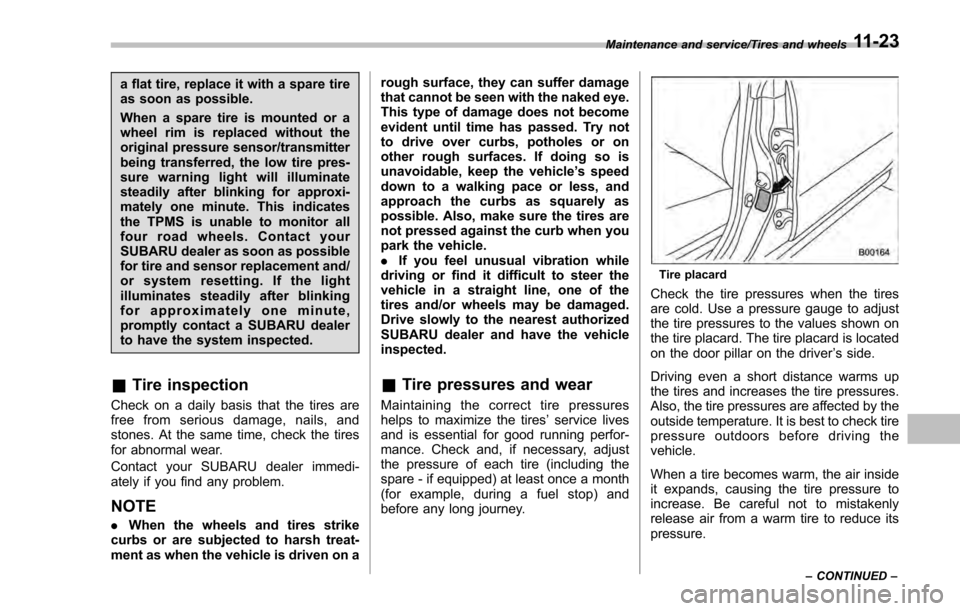
a flat tire, replace it with a spare tire
as soon as possible.
When a spare tire is mounted or a
wheel rim is replaced without the
original pressure sensor/transmitter
being transferred, the low tire pres-
sure warning light will illuminate
steadily after blinking for approxi-
mately one minute. This indicates
the TPMS is unable to monitor all
four road wheels. Contact your
SUBARU dealer as soon as possible
for tire and sensor replacement and/
or system resetting. If the light
illuminates steadily after blinking
for approximately one minute,
promptly contact a SUBARU dealer
to have the system inspected.
&Tire inspection
Check on a daily basis that the tires are
free from serious damage, nails, and
stones. At the same time, check the tires
for abnormal wear.
Contact your SUBARU dealer immedi-
ately if you find any problem.
NOTE
. When the wheels and tires strike
curbs or are subjected to harsh treat-
ment as when the vehicle is driven on a rough surface, they can suffer damage
that cannot be seen with the naked eye.
This type of damage does not become
evident until time has passed. Try not
to drive over curbs, potholes or on
other rough surfaces. If doing so is
unavoidable, keep the vehicle
’s speed
down to a walking pace or less, and
approach the curbs as squarely as
possible. Also, make sure the tires are
not pressed against the curb when you
park the vehicle.
. If you feel unusual vibration while
driving or find it difficult to steer the
vehicle in a straight line, one of the
tires and/or wheels may be damaged.
Drive slowly to the nearest authorized
SUBARU dealer and have the vehicle
inspected.
& Tire pressures and wear
Maintaining the correct tire pressures
helps to maximize the tires ’service lives
and is essential for good running perfor-
mance. Check and, if necessary, adjust
the pressure of each tire (including the
spare - if equipped) at least once a month
(for example, during a fuel stop) and
before any long journey.
Tire placard
Check the tire pressures when the tires
are cold. Use a pressure gauge to adjust
the tire pressures to the values shown on
the tire placard. The tire placard is located
on the door pillar on the driver ’s side.
Driving even a short distance warms up
the tires and increases the tire pressures.
Also, the tire pressures are affected by the
outside temperature. It is best to check tire
pressure outdoors before driving the
vehicle.
When a tire becomes warm, the air inside
it expands, causing the tire pressure to
increase. Be careful not to mistakenly
release air from a warm tire to reduce its
pressure.
Maintenance and service/Tires and wheels
–CONTINUED –11-23
Page 519 of 594
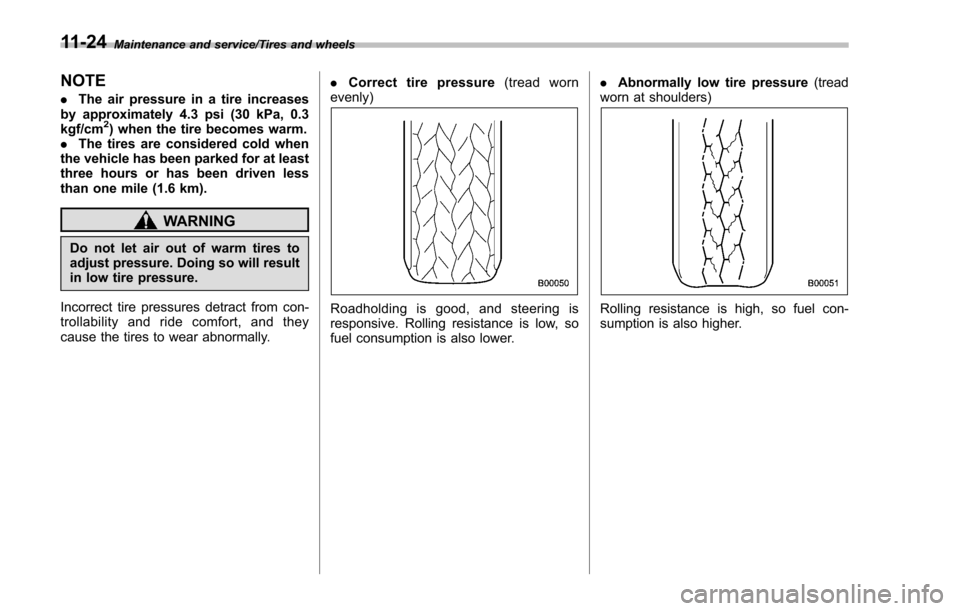
Maintenance and service/Tires and wheels
NOTE
.The air pressure in a tire increases
by approximately 4.3 psi (30 kPa, 0.3
kgf/cm
2) when the tire becomes warm.
. The tires are considered cold when
the vehicle has been parked for at least
three hours or has been driven less
than one mile (1.6 km).
WARNING
Do not let air out of warm tires to
adjust pressure. Doing so will result
in low tire pressure.
Incorrect tire pressures detract from con-
trollability and ride comfort, and they
cause the tires to wear abnormally. .
Correct tire pressure (tread worn
evenly)
Roadholding is good, and steering is
responsive. Rolling resistance is low, so
fuel consumption is also lower. .
Abnormally low tire pressure (tread
worn at shoulders)Rolling resistance is high, so fuel con-
sumption is also higher.
11-24
Page 558 of 594
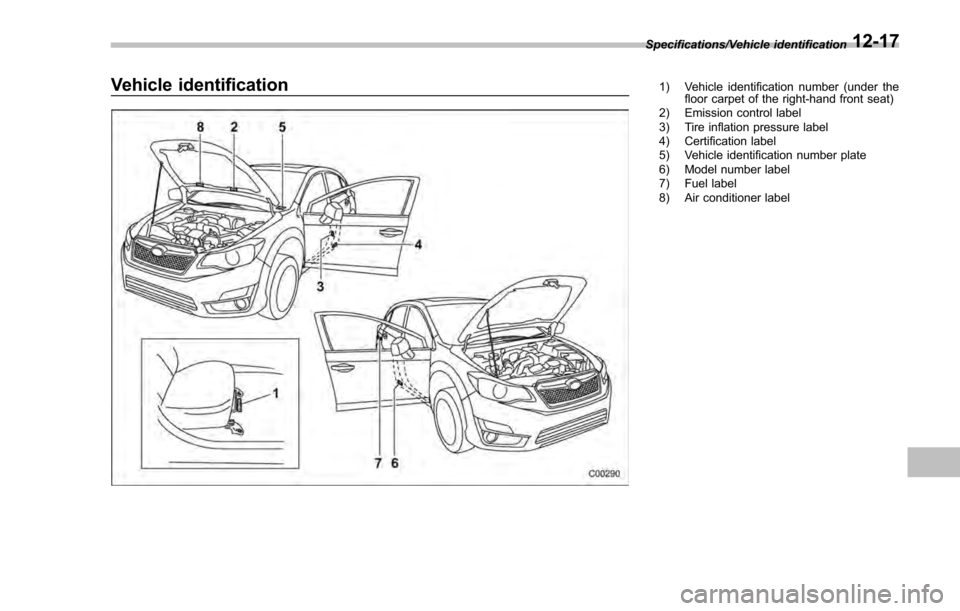
Vehicle identification1) Vehicle identification number (under thefloor carpet of the right-hand front seat)
2) Emission control label
3) Tire inflation pressure label
4) Certification label
5) Vehicle identification number plate
6) Model number label
7) Fuel label
8) Air conditioner label
Specifications/Vehicle identification
12-17
Page 564 of 594
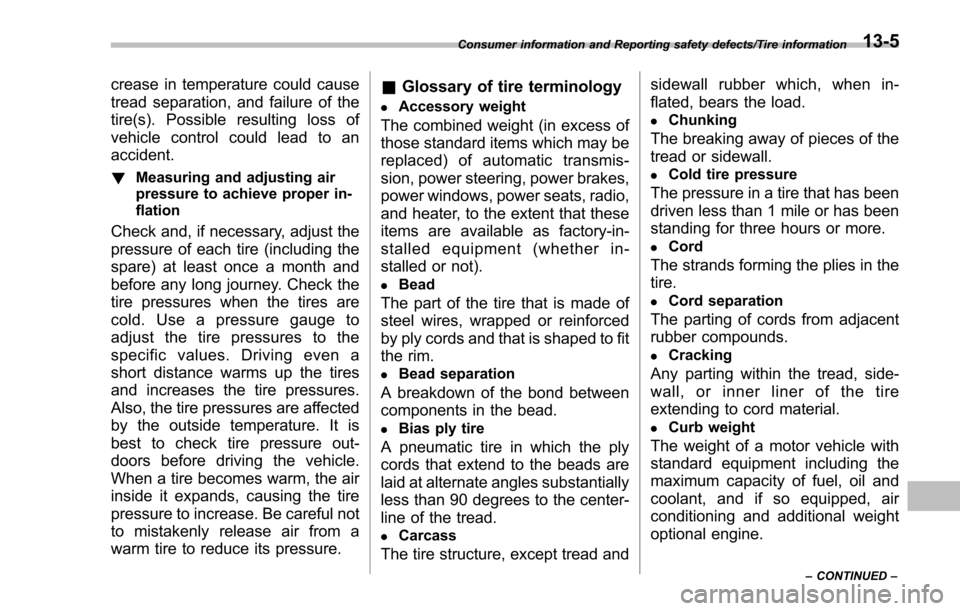
crease in temperature could cause
tread separation, and failure of the
tire(s). Possible resulting loss of
vehicle control could lead to an
accident.
!Measuring and adjusting air
pressure to achieve proper in-
flation
Check and, if necessary, adjust the
pressure of each tire (including the
spare) at least once a month and
before any long journey. Check the
tire pressures when the tires are
cold. Use a pressure gauge to
adjust the tire pressures to the
specific values. Driving even a
short distance warms up the tires
and increases the tire pressures.
Also, the tire pressures are affected
by the outside temperature. It is
best to check tire pressure out-
doors before driving the vehicle.
When a tire becomes warm, the air
inside it expands, causing the tire
pressure to increase. Be careful not
to mistakenly release air from a
warm tire to reduce its pressure.
&Glossary of tire terminology
.Accessory weight
The combined weight (in excess of
those standard items which may be
replaced) of automatic transmis-
sion, power steering, power brakes,
power windows, power seats, radio,
and heater, to the extent that these
items are available as factory-in-
stalled equipment (whether in-
stalled or not).
.Bead
The part of the tire that is made of
steel wires, wrapped or reinforced
by ply cords and that is shaped to fit
the rim.
.Bead separation
A breakdown of the bond between
components in the bead.
.Bias ply tire
A pneumatic tire in which the ply
cords that extend to the beads are
laid at alternate angles substantially
less than 90 degrees to the center-
line of the tread.
.Carcass
The tire structure, except tread and sidewall rubber which, when in-
flated, bears the load.
.Chunking
The breaking away of pieces of the
tread or sidewall.
.Cold tire pressure
The pressure in a tire that has been
driven less than 1 mile or has been
standing for three hours or more.
.Cord
The strands forming the plies in the
tire.
.Cord separation
The parting of cords from adjacent
rubber compounds.
.Cracking
Any parting within the tread, side-
wall, or inner liner of the tire
extending to cord material.
.Curb weight
The weight of a motor vehicle with
standard equipment including the
maximum capacity of fuel, oil and
coolant, and if so equipped, air
conditioning and additional weight
optional engine.
Consumer information and Reporting safety defects/Tire information
–CONTINUED –13-5
Page 584 of 594

L
Lap belt pretensioner.................................................. 1-22
Leather seat materials ................................................ 10-5
License plate light ..................................................... 11-41
Light Backup ................................................................ 11-38
Cargo area .................................................... 6-2, 11-42
Control switch ........................................................ 3-89
Daytime running. .................................................... 3-92
Dome ........................................................... 6-2, 11-42
Front fog ...................................................... 3-94, 11-38
Front side marker ......................................... 3-89, 12-14
Ignition switch .......................................................... 3-6
License plate ........................................................ 11-41
Map ............................................................. 6-3, 11-42
Parking ................................................................ 11-38
Rear combination .................................................. 11-38
Rear side marker light ........................................... 11-38
Stop .................................................................... 11-38
Tail...................................................................... 11-38
Trunk ................................................................... 11-43
Turn signal ................................................... 3-92, 11-38
Loading your vehicle .................................................. 8-12
Low fuel warning light ................................................. 3-22
Low tire pressure warning light .................................... 3-19
Lower and tether anchorage ........................................ 1-33
M
Maintenance Precautions ........................................................... 11-3
Schedule .............................................................. 11-3 Seatbelt.
................................................................ 1-20
Tools ...................................................................... 9-3
Malfunction indicator light (check engine warning light) .... 3-16
Manual Mode (continuously variable transmission) ................. 7-26
Transmission ......................................................... 7-22
Transmission oil ................................................... 11-14
Map light ........................................................... 6-3, 11-42
Maximum load limits ................................................... 8-19
Meters and gauges ...................................................... 3-9
Mirror defogger ........................................................ 3-108
Mirrors .................................................................... 3-100
Moonroof ................................................................... 2-42
Multi function display ................................................... 3-42
Multi information display .............................................. 3-38
N
New vehicle break-in driving ......................................... 8-2
O
Odometer .................................................................. 3-10
Off road driving ........................................................... 8-6
Oil filter ..................................................................... 11-9
Oil level Engine .................................................................. 11-8
Warning light .......................................................... 3-18
Oil pressure warning light ............................................ 3-18
Outside Mirror defogger .................................................... 3-108
Mirrors ................................................................
3
-108
Temperature indicator ...................................... 3-33, 3-47
Index14-7
Page 588 of 594

Vehicle Dynamics ControlOFF indicator light .................................................. 3-25
OFF switch ........................................................... 7-36
Operation indicator light .......................................... 3-24
System ................................................................. 7-34
Warning light ......................................................... 3-24
Ventilator .................................................................... 4-2
Voice command operation ........................................... 5-82
W
Warning and indicator lights ........................................ 3-13
Warning chimes Keyless access with push-button start system ........... 3-25
Seatbelt ................................................................ 3-14
Warning light ABS ..................................................................... 3-21
Access key ........................................................... 3-25
All-Wheel Drive ...................................................... 3-23
AT OIL TEMP ........................................................ 3-19
Automatic headlight beam leveler ............................. 3-31
Brake system ........................................................ 3-21
Charge ................................................................. 3-18
CHECK ENGINE ................................................... 3-16
Coolant temperature high ........................................ 3-17
Door open ............................................................. 3-23
Engine low oil level ................................................ 3-18
Hill start assist ....................................................... 3-22
Keyless access with push-button start system ........... 3-25
Low fuel ................................................................ 3-22
Low tire pressure ................................................... 3-19
Oil pressure .......................................................... 3-18 Power steering
....................................................... 3-23
Seatbelt. ................................................................ 3-14
SRS airbag system ................................................. 3-15
Vehicle Dynamics Control ........................................ 3-24
Windshield washer fluid ........................................... 3-19
Warranties ..................................................................... 1
Warranties and maintenance ........................................ 8-19
Washing .................................................................... 10-2
Waxing and polishing .................................................. 10-3
Wear indicators ........................................................ 11-25
Welcome lighting function ............................................ 3-90
Wheel Aluminum ............................................................ 11-28
Balance ............................................................... 11-25
Nut tightening torque ............................................... 12-8
Replacement. ....................................................... 11-28
Windows ................................................................... 2-35
Windshield Washer fluid. ........................................................ 11-28
Wiper and washer switches ..................................... 3-97
Wiper blades ........................................................ 11-30
Wiper deicer ........................................................ 3-108
Winter Driving ................................................................... 8-8
Tires ........................................................... 8-10, 11-21
Wiper and washer ......................................................
3
-96
Wiper deicer ............................................................ 3-108
Index14-11
Page 593 of 594

GAS STATION REFERENCE
&
Fuel:
Use only unleaded gasoline with an octane rating of 87 AKI
(90 RON) or higher .
&Fuel octane rating:
!RON
This octane rating is the Research Octane Number.
! AKI
This octane rating is the average of the Research Octane and
Motor Octane numbers and is commonly referred to as the Anti
Knock Index (AKI).
&Fuel capacity:
Except Crosstrek models: 14.5 US gal (55 liters, 12.1 Imp gal)
Crosstrek models: 15.9 US gal (60 liters, 13.2 Imp gal)
&Engine oil:
Use only the following oils.
. API classification SN with the words “RESOURCE CON-
SERVING ”
. or ILSAC GF-5, which can be identified with the ILSAC
certification mark (Starburst mark)
For the complete viscosity requirements, refer to “Engine oil”
F 12-4.
&Engine oil capacity:
5.1 US qt (4.8 liters, 4.2 Imp qt)
The indicated oil quantity is only a guideline and is estimated
based on a case when the engine oil is changed with an oil
filter. After refilling the engine with oil, the oil level should be
checked using the oil level gauge. For more details about
maintenance and service, refer to “Engine oil”F 11-8.
&Cold tire pressure:
Refer to “Tires ”F 12-8.